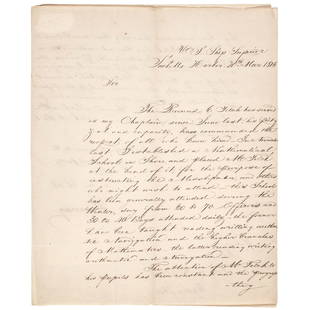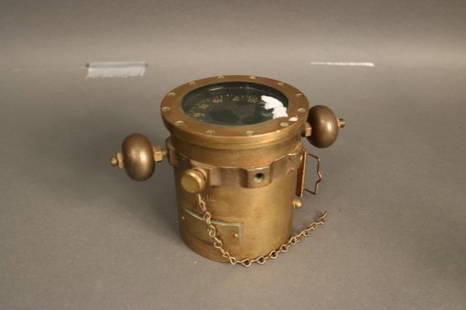
1836 US Navy Commodore JOHN ROGERS ALS
Similar Sale History
Recommended Items






Item Details
Description
Autographs
US Navy Commodore John Rogers Autograph Letter Signed to Daniel D. Brodhead of the Battle of Thompson's Island
JOHN ROGERS (1772-1838). Commodore and Senior United States Navy Officer serving under Six Presidents, in the Quasi-War with France, both Barbary Wars in North Africa, and the War of 1812 with Britain, noted for Commanding the largest American Naval Squadron in his day to sail the Mediterranean Sea.
September 8th, 1836-Dated, Autograph Letter Signed twice, "Jn Rogers", also Signs his "Free Frank" on its Internal Address Leaf, 1 page, measuring 8" x 9.75", Navy Commissioner's Office, City of Washington, Very Fine. Rogers writes to Navy Naval Agent Daniel D. Brodhead (1821-1853 U.S. Navy Agent and broker) in Boston, reading: "The Commissioners enclose herewith contracts and bonds to be executed by Mr. J. Sleeper for all the Slops clothing and shoes required by their advertisement of the 22nd July last, which when executed be pleased to return to this Office without delay." Moderate soil to the outer address leaf, which bears a circular red postal stamp, while the interior is boldly written in rich brown on wove period paper.
John Rogers at times Commanded the United States Navy Frigates: USS John Adams; USS President; USS Constitution; USS Insurgent; USS Maryland; USS Guerriere and was Commander of the United States Mediterranean Squadron. During the War of 1812 Rogers fired the first shot of the war aboard his next flagship, the USS President, and also played a leading role in the recapture of Washington after the Capitol was burned by the British, while also having to endure his own hometown and house burned and his family displaced. Later in his career he headed the Navy Board of Commissioners and served briefly as Secretary of the Navy.
Daniel Brodhead:
On August 11, 1779 Colonel Daniel Brodhead, the head of the Western Department, launched an uncertain campaign against an unconventional Seneca enemy in the wilderness of the Ohio Country. After thirty-five days of long marching through terrible weather, the last vestiges of Western Seneca, or Mingo, culture lay in ruins.
While the Brodhead Campaign has long been overshadowed by more notable northern operations led by Major General John Sullivan and Brig. Gen. James Clinton, lingering questions have made Brodhead's Campaign a curious footnote in the larger narrative of the American Revolution. Amongst the most unique aspects of this campaign was the small yet fiery engagement that occurred some eight days into the expedition known as the "Battle of Thompson's Island."
Brodhead was a natural choice to lead this expedition against the Seneca of the region, and from his earliest tenure at the helm of the Western Department, General George Washington kept him fully abreast of his expectations for the year to come. Brodhead's confidence and regular updates convinced Washington that timely action against potential threats in the Ohio Country would be a tremendous benefit to his overall demolition of the Iroquois heartland.
George Washington's overall objective was "total war" on Iroquoia, and with the aid of Brodhead's Campaign he succeeded in spectacular fashion. In Washington's own words:
"The activity, perseverance, and firmness which marked the conduct of Colonel Brodhead, and that of all of the officers and men of every description in this expedition, do them great honor, and their services entitle them to the thanks, and to this testimonial of the General's Acknowledgment.
_____
John Rodgers (July 11, 1772 " August 1, 1838) was a Senior Naval Officer in the United States Navy who served under Six Presidents for nearly four decades. He served during its earliest formative years in the 1790s through the late 1830s, committing the greater bulk of his adult life to his country. His service took him through many operations in the Quasi-War with France, both Barbary Wars in North Africa and the War of 1812 with Britain.
As a senior officer in the young American Navy he played a major role in the development of the standards, customs and traditions that emerged during this time. Rodgers was, among other incidents, noted for Commanding the largest American squadron in his day to sail the Mediterranean Sea.
After serving with distinction as a Lieutenant he was soon promoted directly to the rank of captain (the rank of Master Commandant did not exist at that time).
During his naval career he commanded a number of navy ships, including the USS John Adams, the flagship of the fleet that defeated the Barbary states of North Africa. During the War of 1812 Rodgers fired the first shot of the war aboard his next flagship, the USS President, and also played a leading role in the recapture of Washington after the capitol was burned by the British, while also having to endure his own hometown and house burned and his family displaced. Later in his career he headed the Navy Board of Commissioners and served briefly as Secretary of the Navy.
Following in his footsteps, Rodgers' son and several grandsons and great-grandsons also became Commodores and Admirals in the United States Navy
US Navy Commodore John Rogers Autograph Letter Signed to Daniel D. Brodhead of the Battle of Thompson's Island
JOHN ROGERS (1772-1838). Commodore and Senior United States Navy Officer serving under Six Presidents, in the Quasi-War with France, both Barbary Wars in North Africa, and the War of 1812 with Britain, noted for Commanding the largest American Naval Squadron in his day to sail the Mediterranean Sea.
September 8th, 1836-Dated, Autograph Letter Signed twice, "Jn Rogers", also Signs his "Free Frank" on its Internal Address Leaf, 1 page, measuring 8" x 9.75", Navy Commissioner's Office, City of Washington, Very Fine. Rogers writes to Navy Naval Agent Daniel D. Brodhead (1821-1853 U.S. Navy Agent and broker) in Boston, reading: "The Commissioners enclose herewith contracts and bonds to be executed by Mr. J. Sleeper for all the Slops clothing and shoes required by their advertisement of the 22nd July last, which when executed be pleased to return to this Office without delay." Moderate soil to the outer address leaf, which bears a circular red postal stamp, while the interior is boldly written in rich brown on wove period paper.
John Rogers at times Commanded the United States Navy Frigates: USS John Adams; USS President; USS Constitution; USS Insurgent; USS Maryland; USS Guerriere and was Commander of the United States Mediterranean Squadron. During the War of 1812 Rogers fired the first shot of the war aboard his next flagship, the USS President, and also played a leading role in the recapture of Washington after the Capitol was burned by the British, while also having to endure his own hometown and house burned and his family displaced. Later in his career he headed the Navy Board of Commissioners and served briefly as Secretary of the Navy.
Daniel Brodhead:
On August 11, 1779 Colonel Daniel Brodhead, the head of the Western Department, launched an uncertain campaign against an unconventional Seneca enemy in the wilderness of the Ohio Country. After thirty-five days of long marching through terrible weather, the last vestiges of Western Seneca, or Mingo, culture lay in ruins.
While the Brodhead Campaign has long been overshadowed by more notable northern operations led by Major General John Sullivan and Brig. Gen. James Clinton, lingering questions have made Brodhead's Campaign a curious footnote in the larger narrative of the American Revolution. Amongst the most unique aspects of this campaign was the small yet fiery engagement that occurred some eight days into the expedition known as the "Battle of Thompson's Island."
Brodhead was a natural choice to lead this expedition against the Seneca of the region, and from his earliest tenure at the helm of the Western Department, General George Washington kept him fully abreast of his expectations for the year to come. Brodhead's confidence and regular updates convinced Washington that timely action against potential threats in the Ohio Country would be a tremendous benefit to his overall demolition of the Iroquois heartland.
George Washington's overall objective was "total war" on Iroquoia, and with the aid of Brodhead's Campaign he succeeded in spectacular fashion. In Washington's own words:
"The activity, perseverance, and firmness which marked the conduct of Colonel Brodhead, and that of all of the officers and men of every description in this expedition, do them great honor, and their services entitle them to the thanks, and to this testimonial of the General's Acknowledgment.
_____
John Rodgers (July 11, 1772 " August 1, 1838) was a Senior Naval Officer in the United States Navy who served under Six Presidents for nearly four decades. He served during its earliest formative years in the 1790s through the late 1830s, committing the greater bulk of his adult life to his country. His service took him through many operations in the Quasi-War with France, both Barbary Wars in North Africa and the War of 1812 with Britain.
As a senior officer in the young American Navy he played a major role in the development of the standards, customs and traditions that emerged during this time. Rodgers was, among other incidents, noted for Commanding the largest American squadron in his day to sail the Mediterranean Sea.
After serving with distinction as a Lieutenant he was soon promoted directly to the rank of captain (the rank of Master Commandant did not exist at that time).
During his naval career he commanded a number of navy ships, including the USS John Adams, the flagship of the fleet that defeated the Barbary states of North Africa. During the War of 1812 Rodgers fired the first shot of the war aboard his next flagship, the USS President, and also played a leading role in the recapture of Washington after the capitol was burned by the British, while also having to endure his own hometown and house burned and his family displaced. Later in his career he headed the Navy Board of Commissioners and served briefly as Secretary of the Navy.
Following in his footsteps, Rodgers' son and several grandsons and great-grandsons also became Commodores and Admirals in the United States Navy
Buyer's Premium
- 30%
1836 US Navy Commodore JOHN ROGERS ALS
Estimate $600 - $800
1 bidder is watching this item.
Shipping & Pickup Options
Item located in Rancho Santa Fe, CA, usOffers In-House Shipping
Payment

Related Searches
TOP







































![1825 US NAVY REPORT TRIAL OF COMMANDER DAVID PORTER THE AMERICAN PIRACY: Year/Century: 19th century Language: English Subject: Americana Binding: Leather Description: [PRESIDENT DAVID PORTER] An Account of the Trial of US Navy Commodore David Porter. 1825 Washington, D.C.](https://p1.liveauctioneers.com/6177/328785/177125893_1_x.jpg?height=310&quality=70&version=1714933470)



![1825 REPORT TRIAL of COMMODORE DAVID PORTER of US NAVY antique AMERICANA PIRACY: [COMMODORE DAVID PORTER] A Report of the Trial of Commodore David Porter of the Navy of the United States. Washington City: 1825 Size 6 by 9.5" viii, 244pp, 68pp. Modern half leather, uncut. Some toni](https://p1.liveauctioneers.com/5584/330217/178021021_1_x.jpg?height=310&quality=70&version=1716324705)









